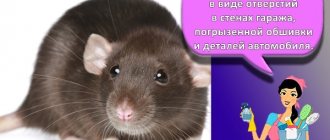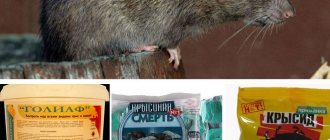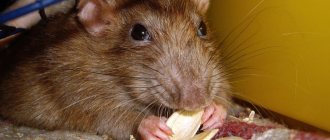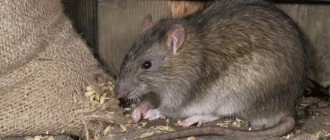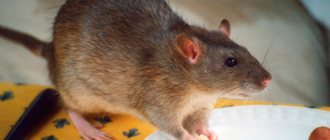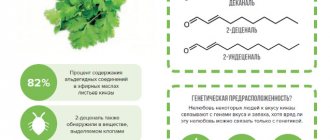What is pest control
Desinexation (extermination of insects) .
Disinsection is understood as one of the types of disinfection, which is the destruction of insects capable of carrying various infections using special chemicals, by exposure to hot water with steam or using biological agents. Disinsection also refers to the procedure for exterminating any insects whose proximity to humans is considered undesirable: flies, mosquitoes, cockroaches, ants, bed bugs, etc.
In simple terms, disinfestation is a set of measures aimed at getting rid of harmful or infected insects.
Types of pest control
- Complete extermination - the use of special means that are lethal to the insects against which disinfestation is aimed.
- Preventive disinfestation is the use of products that create unfavorable conditions for the development and spread of harmful insects in the disinfested area - cockroaches, bedbugs, lice, etc. Prevention consists of keeping the house clean, using protective nets on windows and doors, and preventing harmful insects from entering the room.
Also, in addition to the main types, several different disinfestation methods can be identified.
Disinsection methods
- Mechanical – disinfestation by constantly maintaining the cleanliness of the premises, regular cleaning and washing.
- Physical - this method involves exposure to high temperatures - hot steam, ultraviolet light and direct fire.
- Biological - disinfestation by using other animals, such as birds, to combat parasites.
- Chemical – disinfestation of premises using special chemicals aimed at destroying or creating unfavorable conditions for harmful insects. Usually these are various chlorine-based solutions.
Pest control.
Disinsection is usually carried out in areas where there are a lot of flies, bedbugs, ticks, mosquitoes, lice, fleas and other insects.
To combat adult insects and their embryos, use:
- 0.5-1% aqueous solution of chlorophos,
- 0.5% aqueous emulsion of trichlorometaphos-3 at the rate of 50-150 ml/m2,
- 0.2% DDVF emulsion, 1% karbofos emulsion,
- 0.5% emulsion of methyl metaphos at the rate of 100 ml/m2.
The duration of the residual effect is from 5-7 to 22 days, however, DDVF has a 10-30 times stronger effect on flies than chlorophos, but its effect is shorter.
The main breeding ground for insects is manure storage facilities , so the surface of manure piles is treated:
- 5% creolin solution,
- 10% naphthalizol solution,
- bleach powder containing at least 25% active chlorine,
- 0.1% solution of trichlorometaphos-3 at the rate of 4-5 liters per 1 sq. m.
Germs are sometimes carried in manure and urine, so special care must be taken in cleaning and disposing of manure from sick animals. Typically, manure is disinfected by composting or biothermal treatment.
Since when composting manure, the height of the pile should be no more than 2 m, and the manure should be interspersed with a layer of earth or peat, with the biothermal method of disinfection, the pile is laid from one manure no more than 1.5 m high and 2.5 m wide.
When biothermal disinfection of manure, a layer of uncontaminated manure or straw 20-25 cm thick is laid down, then contaminated manure is laid in a cone to a height of up to 125 cm. The infected manure is covered with a layer of straw 15 cm thick on top, and a layer of earth 15-20 cm is laid on top of the straw. Manure folded into piles is gradually heated to 70-75°.
Biothermal treatment of manure.
Bacteriological studies of the Research Institute of Veterinary Sanitation have established that under such conditions:
- foot-and-mouth disease and Aujeszky's disease viruses died on the 5-9th day,
- pathogens of brucellosis,
- paratyphoid and swine erysipelas - after 22 days,
- Mycobacterium tuberculosis - after 29-30 days.
Manure obtained from animals suffering from anthrax, emphysematous carbuncle, glanders, infectious anemia, rabies, brodzot, paratuberculous enteritis and rinderpest is pre-moistened with a disinfectant solution and burned.
What is deratization
Deratization (extermination of rats) is a set of measures to exterminate various types of rodents (mice, rats, voles, etc.). The deratization procedure is quite dangerous and must be carried out by a specially trained person, subject to a set of safety measures. If handled improperly, you can not only get rid of rats, but also cause irreparable harm to human health and pets.
Main types of deratization:
- Preventive deratization is a set of measures that are aimed at eliminating favorable conditions for the appearance of various types of rodents. This type of deratization includes, for example, blocking access of rodents to places suitable for making burrows or blocking access to food.
- Exterminatory deratization is measures that are taken when rodents have already appeared in a room and aimed at their complete destruction and taking measures for this.
Deratization can be carried out in different ways; usually one of the three methods of deratization listed below is used.
Main methods of deratization:
- The mechanical method is a method based on the use of various mousetraps, rat traps, traps and other traps.
- The chemical method is a method that uses various types of baits poisoned with poisons, or so-called raticides.
- Biological method is a method in which domestic animals that hunt them are used to kill rodents. This method is prohibited in enterprises.
- Gas method - this method is mainly used in field conditions and in small confined spaces - ships, cars, airplanes, etc.
Deratization of territories
Deratization of territories is very different from a similar procedure indoors. This is due to the fact that in this case it is difficult for a person to control the reproduction and spread of rodents (most often these are moles and field mice), which can sometimes simply appear from the side. In this case, it is important to introduce an effective control system and carry it out with increased regularity.
Most often, voles are inventive, and therefore chemical control methods are not always effective. In such cases, specialists actively use conventional physical traps, which allow them to catch random rodents and thus regulate their numbers.
If you still decide to poison mice and moles, then this procedure must be performed 3 times a year - in spring, summer and autumn. In winter there is no need for this, since the animals hide and you simply cannot reach them. In the spring, when rodents begin to actively reproduce, it is worth taking all possible measures to suppress such processes.
If you only place traps around buildings and in fields, then such deratization can be carried out on an ongoing basis. This means that you can place traps in the most necessary places once, and therefore once a week you can go around them, remove any animals you come across and change locations. This method is most effective if you carry out pest control on your own without seeking help from special organizations.
Two types of deratization
- Preventative
- Fighter
Preventative
Preventive deratization must be carried out constantly in order to prevent rodent infestations. An excellent means of defense is to block theoretically permissible places for their intrusion into the premises.
Fighter
Exterminatory deratization is carried out if rats have already settled in the facility. It includes a whole series of actions that help drive out the treated area or exterminate the entire population.
Professional pest control
Turning to the services of the Sanepidemstation.com service has already proven its effectiveness even in cases where it was a question of almost hopeless efforts in the fight against rodents. In the course of deratization, professionals use proven and reliable pesticides that can permanently rid a residential property - a house, a cottage - from pest invasion. To treat rat holes, aeration technology can be used, which allows for the spraying of a contact-action pesticide in the habitat of the rats. For long-term control, if the home is heavily infested, professional traps are used, and upon completion of the extermination of the population, it is recommended to install barrier protection against repeated encounters with pests.
If the fight against rats on your own is not successful, you should trust professionals for whom exterminating rodents is a routine procedure. Both in a country house, and in a cottage or mansion outside the city, order will be restored by specialists, and pests can be forgotten.
Features of deratization
Professional pest control, which is carried out exclusively by professional companies, is carried out in strict sequence and always in compliance with certain requirements. The sequence of such processing is as follows:
- First of all, specialists will visit the site and assess the situation, during which the approximate number of rats and the places where they are most concentrated will be revealed.
- After clarifying all the features, professionals will develop their own tactics for exterminating rodents in each individual case. The most suitable method for exterminating parasites is selected depending on what category the room belongs to.
- The next stage is the direct destruction of rats. The duration of room treatment can range from thirty minutes to several hours.
- After processing, specialists will necessarily check the quality of the work performed and, in case of ineffectiveness, will carry out repeated processing.
As practice shows, the effectiveness of professional treatment of premises is very high and basically always leads to the desired results, and repeated deratization is carried out only for preventive purposes.
The efficiency of professional room treatment is very high
The only thing to consider in such cases is that treating the room yourself may not bring the desired results. Rats are quite unique creatures and when treating a room with the same means, they get used to them and the effectiveness is significantly reduced. That is why the fight against rodents at a professional level gives tangible results and ultimately leads to the destruction of the rodent population.
When choosing a company for pest control, you should make sure that they have a license to carry out this type of treatment. This will first of all guarantee that the rodent control procedure will be carried out in compliance with all rules and regulations.
What is the name of rodent control in an enterprise?
To find the maximum useful information on the issue of pest elimination, you first need to understand the terminology and find out what rodent control at an enterprise is called in the legislative lexicon. In the norms of the SES and on all sites dedicated to the fight against parasites, rodent extermination services are classified as “Deratization” from the Latin Rattus - rat, and the prefix “de-” indicates the liquidation nature of the procedure.
Deratization can be carried out using different methods. Chemical treatment of a room is not always the most effective and only necessary method. Only a sanitary service specialist can select the optimal option after an in-depth analysis of the situation at each enterprise. Some companies have a full-time employee who deals with these issues, but these are isolated cases rather than common practice. It is much cheaper and easier to conclude contracts for a year or longer with special sanitary and epidemiological service companies that deal with the prevention and elimination of rodents, insects, bacteria and unpleasant odors in enterprises of any type.
Calculator
Calculate the cost of exterminating rodents on the site
Why is deratization necessary?
The fight against rodents has been going on for as long as the fact of centralized human settlement has existed. However, there is no technique that allows you to get rid of this threat once and for all. Deratization is required for houses and apartments, industrial enterprises and retail outlets. The extermination of rodents is carried out at commercial and industrial facilities with a certain frequency, depending on the level of their social significance and potential danger. To prevent the threat from spreading, sanitary service specialists, as prescribed by Rospotrebnadzor, carry out sanitization.
Processing organizations must be properly certified and accredited. It is the employees of such companies who have sufficient experience and qualifications to carry out the necessary activities. In addition, only professional rodent extermination makes it possible to successfully maintain appropriate safety measures. Deratization is carried out not only for extermination purposes. In addition, preventative treatment against rodents should be carried out regularly. It is important to understand that manufacturing facilities typically have ongoing pest control measures in place. Pest-control allows you to effectively monitor the occurrence of new dangerous pests. In this case, the extermination of rodents is usually required much less frequently, because the measures taken effectively inhibit the proliferation of pests and allow them to be repelled.
At facilities included in a category of special epidemiological significance, deratization is carried out strictly according to schedule, at least once a month. This includes important transport hubs: airports, train stations, hospitals and clinics, schools and kindergartens. In addition, customs terminals, transport enterprises and car depots, logistics and warehouse complexes are regularly processed. Public catering establishments also have the status of high-risk facilities. All these and many other objects require that rodent control be carried out using professional means, methods and technologies. Without timely elimination of the source of danger, it will be almost impossible to pass inspections regularly carried out by sanitary services.
Pest control of public catering
Places where people gather and cater for them are subject to special requirements from organizations that regulate the sanitary and epidemiological condition of such facilities.
This increased attention is due to the constant presence of food products on the premises, as well as the large amount of work for each employee. For this reason, catering administrations often lack the ability to carry out normal cleaning and disinfection, which makes such places a breeding ground for infection, rodents and insects. And this directly affects the safety of people who come to eat at public catering establishments.
According to general standards, pest control in public catering establishments must be carried out quarterly, that is, 4 times a year. At the same time, it is advisable to avoid significant use of chemicals, which may compromise the safety of premises for people (workers and visitors). Particularly popular in this case are sticky tapes and all kinds of traps that can quickly reduce the rodent population.
It is important to remember that without an adequate cleaning system, deratization will be pointless, because the number of mice will quickly recover to its previous size due to easy access to food. That is why catering workers must carry out regular cleaning, securely hide all supplies in pantries and refrigerators at the end of the working day, and also minimize access to water for mice.
Why do you need to do it?
Unsanitary conditions in the city
Unsanitary conditions are one of the main threats to a civilized society. Regulation of the rodent population is absolutely necessary both on private territory and on objects for various purposes. Failure to take timely measures will lead to the following problems:
- Massive increase in numbers. Rodents are not afraid of humans and actively breed in basements and attics of residential buildings. Just one female per season is capable of producing abundant offspring.
- Spread of deadly infections. Rodents carry rabies and many other viral diseases and negatively affect the general condition of the environment. In addition, they can carry some types of blood-sucking parasites.
- Damage to property. Pests can even undermine the foundation of a building. And they don’t spare supplies and interior items at all, if they contain food items. That is why the fight against rodents: rats, mice, moles, is of great importance for the protection of property interests. Otherwise, you can easily be left without a harvest or supplies for the winter, and spoil an expensive product.
- The appearance of a specific odor. The presence of pests in the premises will not go unnoticed precisely because they leave traces of their vital activity. Feces, urine, and animal fur have a very specific aroma that can cause allergic reactions. In addition, fumes in general are quite hazardous to health and do not improve the atmosphere in the house.
Professional rodent control is carried out by service specialists in all necessary cases - both as part of an emergency visit by rodent control agents and during planned activities. In our work, we use exclusively certified chemicals approved for use in the Russian Federation. To catch animals, if the nest is located outside the walls of the building, mechanical traps are used that can capture the pest without additional effort and remove it from the premises in the future. Specialized organic and inorganic preparations—pesticides—are used to kill rodents within the population. This method is used for total clearing of an area and is available only to professionals.




